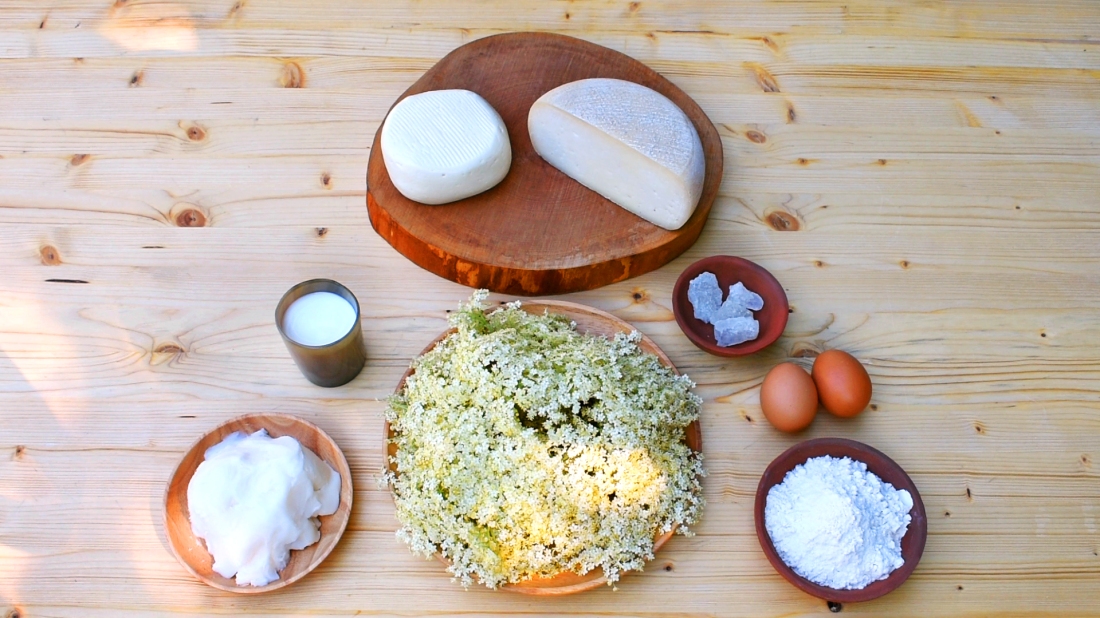Flowers and fruit were often used as ingredients during the Middle Ages and Renaissance to prepare sauces, for both meat and fish, soups and fritters. Today, we prepare fritters with spontaneous flowers that bloom abundantly among the hills where we live: elderflowers. We find them in many medieval and Renaissance sources to prepare soups and fritters. Elderflowers and elderberries are still used in some Italian regions to prepare syrup, marmalade, juice, and fritters.
This time, we chose the recipe of fritters written by Maestro Martino, the most famous Italian cook of the 15th century. His cookbook, Libro De Arte Coquinaria (book of culinary art), is one of the best sources for the historical cuisine and his recipes are a meaningful connection between late medieval and Renaissance methods.
Below, you will find a note about the ingredients and the original text with the translation into English.
Ingredients
elderflowers
aged cheese
fresh cheese
wheat flour
eggs
white cane sugar
milk
lard
Method
Grind the sugar. Pound well in the mortar the aged and fresh cheeses, then add flour, sugar, egg whites, and a little milk. Separate the elderflowers from the stems and add to the cheese mix carefully, without ruining or squeezing the flowers.
Shape the fritters, deep-fry them into hot lard, and serve immediately.
Note about the ingredients
Maestro Martino suggests using lard, butter, or oil for this recipe. In the last case, you should use extra virgin olive oil to prepare a philological dish. We used lard, one of the most common cooking fats during the Middle Ages and Renaissance.
The author doesn’t give directions about what cheese we have to use. We chose an aged sheep cheese and a fresh cow cheese.
Sugar was a common ingredient in the Middle Ages and Renaissance, but was known also throughout the Antiquity. During the Middle Ages, it was used more as a spice than as a sweetener. In this recipe, Maestro Martino is aiming at a balance between flavors, so we suggest do not use too much sugar, just a little bit. We are using here white cane sugar. Ingredients like sugar or flour were considered of better quality if perfectly white and without any kind of impurity. Brown sugar and whole flour, cheaper than the white ones, were used by common people and considered unfit for the table of a noble.
Original text
Per fare frictelle de fior de sambuco. Habi de bono caso frescho, et un poco di bon caso vecchio, et fa’ che siano molto bene pesti et con essi metti un poco di fior di farina et di bianchi d’ova secundo la quantità che vole fare, item un pocho di lacte et del zuccaro; et macinate molto bene tutte queste cose inseme, cavatele del mortare, vi giognirai di fiori di sambuco abastanza secundo che pare a la tua dicretione; et li ditti fiori non vogliono essere né pesti né rotti, facendo la ditta compositione né troppo chiara, cioè liquida, perché possi fare le frittelle tonde con mano overo in quale altra forma ti piace, mettendole a frigere in bono strutto o botiro, overo in bono olio; et calde calde le manda in taula.
Translation
To make elderflower’s fritters. Take good fresh cheese and a little quantity of good aged cheese. Pound them well and mix with a little superfine flour and a number of egg whites according to the quantity you want to prepare, then a little milk and sugar. Grind well everything together, draw out the paste from the mortar, and add enough elderflowers at your discretion. These flowers ought to be neither pounded nor broken, and the mix ought to be not too clear, this is to say liquid, so you can form with your hand fritters round or in any other shape you like. Deep fry in good lard or butter or good oil, and serve the fritters still hot.
Recipes
Renaissance Meatball Skewers VIDEO
Renaissance Crostini with Guanciale and Sage VIDEO
Renaissance Pork Skewers VIDEO
Renaissance Pork Tenderloin with Garlic Sauce VIDEO


